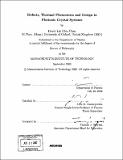Defects, thermal phenomena and design in photonic crystal systems
Author(s)
Chan, David Lik Chin
DownloadFull printable version (19.80Mb)
Other Contributors
Massachusetts Institute of Technology. Dept. of Physics.
Advisor
John D. Joannopoulos.
Terms of use
Metadata
Show full item recordAbstract
The physics of blackbodies has been an ongoing source of fascination and scientific research for over a hundred years. Kirchhoff's law states that emissivity and absorptivity are equal for an object in thermal equilibrium. Coupled with the Second Law of Thermodynamics, one can show that no object can emit more than a blackbody at any given frequency, direction or polarization. While this provides a theoretical maximum to the intensity of thermal emission from an object, few come even close to the level of emission exhibited by a blackbody. Thus, there is much room for research into enhancing thermal radiation from many different types of materials. The ability to modify or tailor the thermal emission profile of an object is of great importance and interest in many areas of applied physics and engineering. It turns out that thermal emission spectra can be changed by altering the geometry of the system or the materials used. For instance, nanoscale patterning can enhance emission at certain frequencies, while point defects can localize light at microcavities. General periodic electromagnetic structures, also known as photonic crystals, are therefore a natural medium in which to carry out such investigations, since they are metallodielectric systems that lend themselves relatively easily to sub-wavelength scale patterning and design. (cont.) This research program aims to study, through both theoretical and computational means, physical phenomena that drive thermal emission in photonic crystals and the design of point defects in the presence of fabrication constraints. First, we explore point defect geometries in inverted opal photonic crystals that can be fabricated by colloidal self-assembly. We identify and study substitutional point defects that introduce a usable defect band into the photonic band gap. It is found that a silica sphere of radius between 0.33a and 0.35a (where a is the lattice constant) introduces a triply degenerate state into the band gap. Reflectance and local density of states calculations are performed to verify the existence and frequency of this defect. Such a defect can be used as a microcavity for localizing light at a point, with a quality factor Q that is limited primarily by the proximity of the defect to the surface of the photonic crystal and other such defects. Second, we present a useful framework within which we can understand some of the physical phenomena that drive thermal emission in one- and two-dimensionally periodic metallic photonic crystals, emphasizing phenomenology and physical intuition. We find that polarization and periodicity play key roles in determining the types of physical phenomena that can be excited in these systems. (cont.) Promising structures in both 1D and 2D systems are identified as good candidates for thermal design. We discuss how the emissive properties of these systems can be tailored to our needs. Third, we establish that the significant enhancement of thermal emission via Q-matching, which has been possible in 1D systems only, can be extended to 2D systems by means of Fano resonances in the 2D system. We demonstrate through detailed numerical and analytical studies that the Fano resonances characteristic of 2D-periodic photonic crystal slabs can be understood in terms of a 1D-model, thereby showing the existence of essentially 1D behavior in a 2D system. Moreover, we show how properties of these spectra can be controlled by changing the geometrical parameters of the photonic crystals. This work provides a path to the creation of graybodies that have tailored thermal emission spectra, with highly anomalous behavior. Fourth, we perform direct thermal emission calculations for 2D- and 3D-periodic photonic crystal slabs using stochastic electrodynamics following the Langevin approach, implemented via an FDTD algorithm. (cont.) We demonstrate that emissivity and absorptivity are equal, and thereby numerically verify Kirchhoff's law, by showing that such photonic crystal systems emit as much radiation as they absorb, for every frequency, up to statistical fluctuations. This has been an issue of great controversy because of experimental work indicating the violation of Kirchhoff's law. We also study the effect of surface termination on absorption and emission spectra from these systems.
Description
Thesis (Ph. D.)--Massachusetts Institute of Technology, Dept. of Physics, 2006. Includes bibliographical references (p. 143-150).
Date issued
2006Department
Massachusetts Institute of Technology. Department of PhysicsPublisher
Massachusetts Institute of Technology
Keywords
Physics.